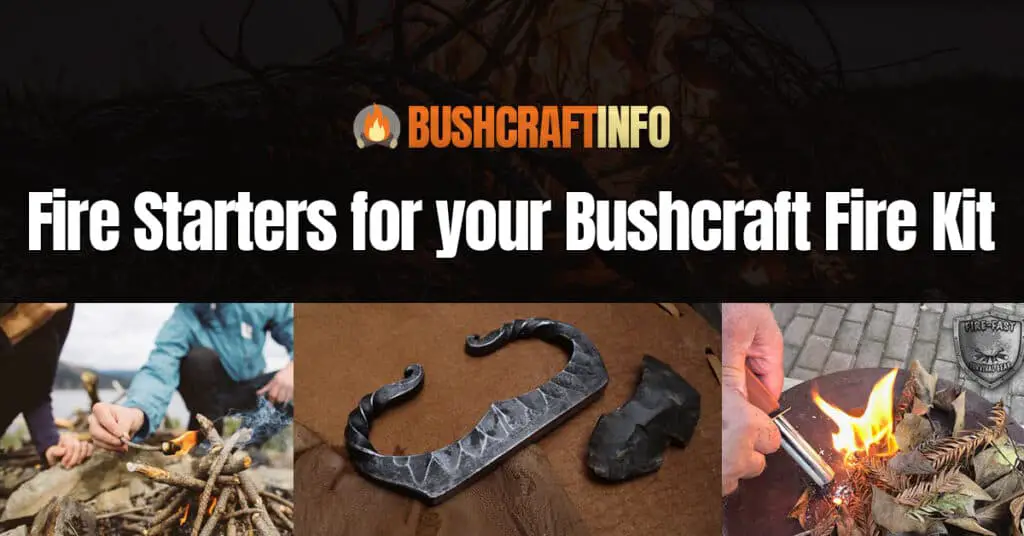We’ve all been there. You’re in the bush for a week of survival in the wilderness, you break out your trusty fishing rod or set up your survival fish trap and you wait… and you wait… and before you know it the week is up and you go home SKUNKED!
In this survival fishing tips blog post I intend to put a stop to that, I will be sharing my best Tips to catch fish with YOU. So if you take the time to keep reading with me I can all but guarantee you will not be leaving your next bushcraft fishing trip empty-handed.
Let’s get into it!
Bushcraft Fishing Techniques
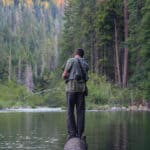 When you are out practicing bushcraft working on your survival skills what starts off as a fun getaway trip can oftentimes become a real survival situation where you are left scavenging for food.
When you are out practicing bushcraft working on your survival skills what starts off as a fun getaway trip can oftentimes become a real survival situation where you are left scavenging for food.
You would be hard-pressed to find a better and more reliable food source than fish. So let’s go over some of the best survival fishing techniques that will help ensure you don’t get skunked!
Primitive Fishing Traps
There are many different forms of primitive fishing traps out there. The best thing about using traps for survival fishing is that they can be set and forgotten about while you go off and do other things like starting a fire.
- Funnel Basket Fishing Trap
One of the most popular primitive fishing traps used today is called the funnel basket fish trap which is very easy to make and setup.
The funnel goes inside of the basket which allows fish to swim into your trap through a tiny opening trying to obtain the bait you set out for it. Once the fish lands inside the main basket it is no longer able to find its way out of the trap.
- Minnow Trap
There are not bait stores when you are in the wilderness so that leaves you responsible for obtaining any live bait you wish to finish and what I find works best is Minnows.
All you need to do to create a Minnow Trap is to create a shallow pool using either rocks or the mud in the water. Leave a small opening in your pool and wait. Much like the funnel basket fishing trap, once inside the pool the Minnows will not be able to find their way back out.
- Trotline
Trotlines are one of my favorite survival fishing traps. They are super easy to make and another form of passive fishing.
To set up a trotline for survival fishing you start by finding the area you want to set it up in, preferably in the narrow end of a creek or river where it’s deep but not deep enough where you can’t place a stick that sticks out of the water.
Take some cordage and tie it to a branch or stick in the ground from one side of the creek/river to a branch or stick on the opposite side of the river, grab some fishing line with hooks already installed and spread them out across your newly set up trotline. Make sure they are long enough so that they submerge a good few inches into the water and are spread out a solid foot or so. Attach your bait of choice to the hooks and you are set!
- Fishing Weir
A fishing weir is an obstruction, fence, or wall placed into flowing water designed to traffic fish towards your trap.
Fishing weirs have been used for thousands of years since prehistoric times and are largely used today. Why? Because they just work!
Fun fact, fishing weirs are an essential tool today for the research and management of salmon and trout stock up in Alaska. They help Fish and Gamer workers count the fish moving up and downstream.
Catching Fish With a Net
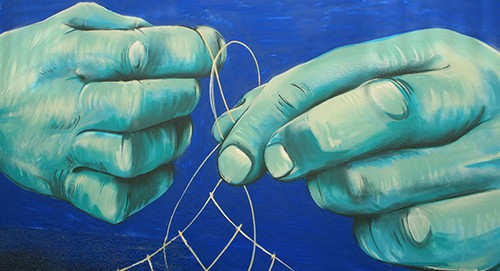
One way to catch fish in what could be a survival situation is with a fishing net.
Fishing by net is usually done to catch the smaller baitfish like minnows that you can then use to catch the real lake monsters. But if you are patient enough, you are sure to catch some dinner.
Most people don’t bring a survival fishing net with them into the bush and that’s fine, all you need to make your own survival fishing net is a flexible forked stick some paracord, and survival netting which is also referred to as “survival hammock”
Handline Fishing
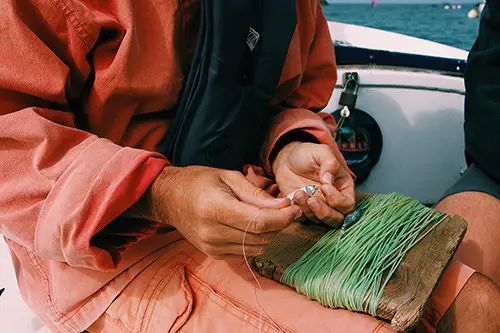
Handline fishing is basically exactly what the name insinuates, fishing using nothing but your hands, some line, a hook, and bait.
This method is great because it means you do not have to bring a fishing rod with you, reducing the weight of your bushcraft backpack.
You can tie a rock to the line as weight and toss the line out by hand, or you can even wrap all the line you have around a smooth piece of wood and use that as a survival fishing reel of sorts.
Spearfishing
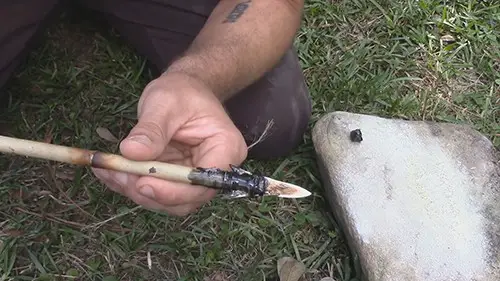
Now, you are survival fishing not on a chartered yacht so you won’t be using things like spearfishing guns.
No, you will be making your own spear out of mainly wood and either shaped metal, stone, or bone for the spearhead.
Spearfishing is not as hard as you would think but it does require a tremendous amount of patience.
The major factor when survival spearfishing is compensating for refraction, refraction is the change in direction of a wave passing from one medium to another or from a gradual change in the medium.
So basically, aim below the fish.
Survival Fishing Requires Patience
I can not stress enough, when you want to get better at something like survival fishing you need two things; Patience and Practice.
You only get better at something when you practice it and bushcraft fishing is no different.
Read all the survival fishing tips blog posts and watch all the youtube videos you want on how to get better at bushcraft fishing, if you don’t get out and experience it for yourself there is no way you can get better and ultimately succeed in not getting SKUNKED!
Finding Bait For Fishing
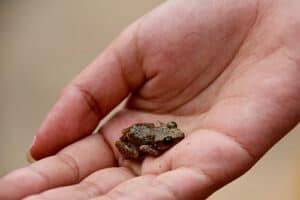
The best type of bait for bushcraft fishing is live bait, hands down. The good thing about being in the wilderness is you will always be able to find some good live bait.
The most common live bait to find are often; worms, leeches, frogs, fish eggs, grubs, or minnows. Fish love all of the above and you will have a hard time getting SKUNKED when fishing with any of these.
You want to be careful when baiting your hook, if it’s baited too loose the fish will take your bait and have itself a nice free meal. Always make sure you are pushing the bait all the way up the shaft of the hook.
If you happen to catch a fish, while you are gutting and preparing your fish make a point to open up the stomach and see what the fish has been eating to pinpoint the perfect bait to use at that time.
What Survival Fishing Gear to bring?
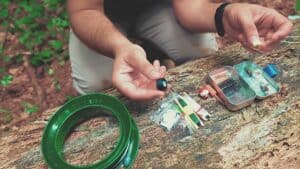
Bushcraft Fishing Rod
A lot of things go into finding the best bushcraft fishing rod, including what part of the world you are living in, what type of water you have around you whether it be a lake, ocean, river, etc. Most importantly is the season or more specifically optimal fishing season.
However, a good bushcraft fishing pole will come in handy and work for you no matter the conditions.
Some people choose not to bring a fishing rod with them when practicing their survival skills in the bush, mostly due to the weight. But I find the weight not to be an issue if you select the right survival fishing pole, and mine always comes in handy when it’s time to catch dinner. You just have to make the right decision for your needs.
Survival Fishing Line
In this instance, I am going to refer to the fishing line as a survival fishing line for a good reason.
Your fishing line or should I say the choice of line can make or break your bushcraft fishing experience. You do not want to bring monofilament fishing line with you, instead, I would opt for at LEAST a 10lb braided fishing line.
I find Monofilament to be too flimsy and is more prone to snapping whereas the braided line is as tough as they came and presents you with less of a risk of losing your fish.
Circle Fishing Hooks
I prefer to bring Circle Fishing Hooks with me when I am survival fishing as they are the best performing hook for trotlines.
When I’m fishing I am not always using my fishing rod, a lot of times I like to set trotlines with these hooks so I can catch fish while accomplishing other tasks. However, circle fishing hooks do work great on a rod as well so I always carry some in my bushcraft fishing kit.
Bushcraft Fishing Without Fishing Equipment
When I say without fishing equipment, I mean mainstay items like fishing poles. Whenever you head out into the bush you should ALWAYS have some braided fishing line packed away. If you always have some fishing line on you, you can always fish. Specifically using the Handline fishing method we talked about earlier in this blog post.
However, if you do not have ANY fishing equipment on you at all, you can create a makeshift fishing line from the fabric of your clothing, pieces of plastic, paracord or even dental floss!
If you don’t happen to have any survival fish hooks on you, you can craft your own out of items found in your surroundings or in your pack. I find safety pins work great for making fish hooks.
You could also create what is known as a Gorge hook. Gorge hooks have been used for thousands of years and are made using a sharp bushcraft knife and a good size stick, choose the size of the stick based on the size of fish you are going for.
How to Find Fish In a Lake
When trying to find fish in a lake the major thing you need to consider is the season. Fish are seasonal creatures and there will always be the best and worst times to catch them, so be sure to plan around that.
If you aren’t on a boat and don’t have a fish finder you will be relying on your own fish finding skills to find food, I wouldn’t have it any other way. Fish can be in many different spots around a lake. You should be focusing on areas where fish food will be, this usually tends to be in weed beds, flooded wood cover, or along rock walls.
You are better off trying your luck in spots fish like to feed than just tossing your line in the middle of the lake. These feeding areas are also great spots to set up your fishing traps we talked about earlier.
How to Find Fish In a River
Finding fish in a river can often be a bit harder than finding fish in a lake. Fishing a riverbed you will need to brainstorm where you think the fish will be hiding away from predators and the current.
Areas with sunken trees or branches hanging overhead are more likely to hold fish but there are many other places in the river where fish will be.
Something to consider when looking for fish in a river is the current of that river. If the current is moving fast fish will oftentimes try and find safety in little pools off to the side of the river where the current isn’t so strong.
Look for little boulders or islands in the middle of the river, fish often tend to rest behind these things as it provides a break from the strong currents.
How to Make a DIY Bushcraft Fishing Kit
We talked about what kind of survival fishing gear you should be bringing with you on your trips but let’s talk about why you should consider making your own DIY bushcraft fishing kit.
A bushcraft fishing kit usually includes a few things;
- Compact telescoping fishing rod
- Braided fishing line
- Whichever fishing hooks you prefer
- Paper clips (for if you lose all your hooks)
- Your choice of lures
- Multi-tool
- Knife
You can customize your bushcraft fishing kit however you like but remember it is best to think compact and minimalist so as to not weigh you down on your trip.
Conclusion
Nothing is worse than spending hours fishing and coming back home empty-handed, especially if you are survival fishing. You need that food to survive and thrive after all. Hopefully, you can learn from these important bushcraft fishing tips and techniques so that you never get SKUNKED while fishing in the wild again.
Was this post helpful?
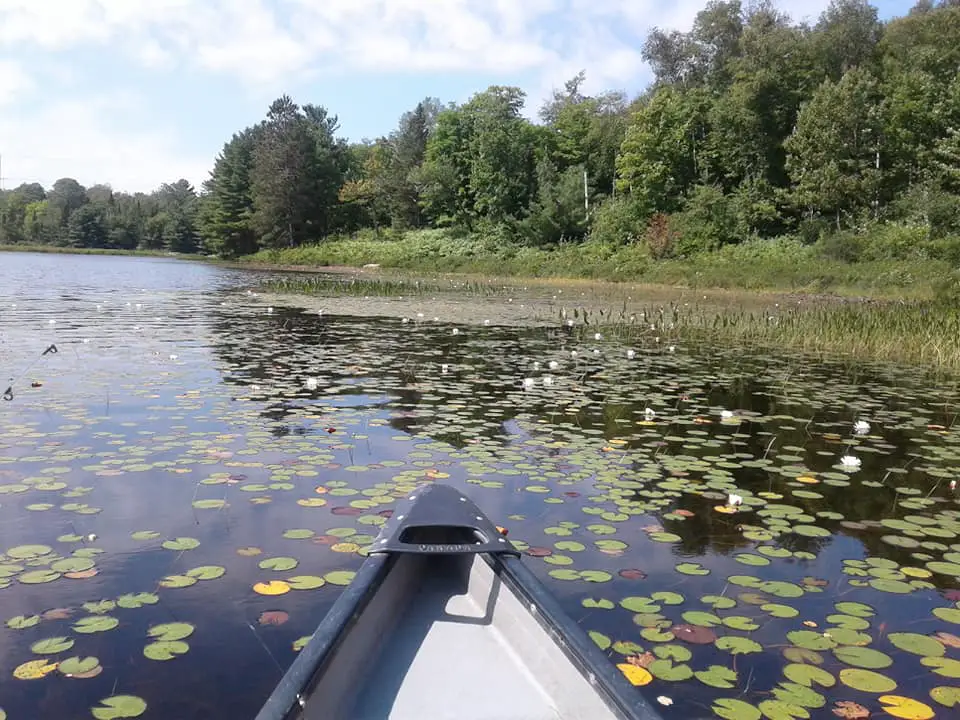
Hey I’m Josh! I have been practicing Bushcraft for a little over 6 years now! I Started this website to review awesome bushcraft gear that I love as well as share information I have learned along the way!

